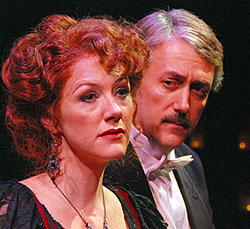Director’s Notes: A Little Night Music
Cygnet Theatre is excited to revisit A Little Night Music. Director Sean Murray shares his thoughts on this popular musical.

When Stephen Sondheim and Hal Prince began to work on their next collaboration following Company and Follies, they were responding to criticisms that these works, both explorations of the difficulties and anxieties of marriage, were cold and overly intellectual. They set out to prove in their third effort that they could also create something both commercial and adult.
After a search, Sondheim/Prince found in an Ingmar Bergman film, Smiles of a Summer Night, the perfect material for their sophisticated sex comedy: mismatched couples, longing, regret, reconciliation, all under the magical dusk of the Summer Solstice. Literature is filled with such stories as mismatched lovers leave their world of society, etiquette and rules and find themselves in a forest or garden and return to society transformed. Think A Midsummer’s Night Dream, As You Like It, Into the Woods or any of the fairy tales of the Brothers Grimm.
Sondheim is famously obsessed with games and crossword puzzles and often thrives when creating musical and linguistic challenges for himself. In adapting Smiles of a Summer Night into a musical format, he came upon the realization that the film is filled with the number three: three smiles of the summer night, the three generations of the Armfeldt women, the three misaligned couples. The essential energy of the number three is unstable. Three wants to pull towards the more solid number two. A love triangle needs to resolve itself into a single couple. Each character finds themselves locked into an unsatisfactory triad: Fredrik-Anne-Desiree, Fredrik-Desiree-Carl Magnus, Desiree-Carl Magnus-Charlotte, Charlotte-Desiree-Carl Magnus, Anne-Charlotte-Fredrik, Petra-Henrik-Anne, etc. In Night Music, even the songs that are sung by two characters together are almost always about a missing third person! It takes the smiles of that summer night to transform these triangles into couples and reconcile them to get to our story’s resolution.
Inspired by the number three, Sondhiem set for himself the challenge of writing the entire score based upon variations of the waltz. (Alright, there is one very short segment of underscore that is not in waltz time!) But the lilting waltz time in the score definitely lends the story the air of elegance and magic. Sondheim’s score is firmly rooted in the Viennese operetta. The show-opening “Night Waltz” provides the perfect theme for these variations of three—both musically and dramatically. Sondheim uses this as his framing device, saying that “the whole score would feel vaguely like a long waltz with scherzi in between so that no song would seem to have come from another texture.” Sondheim puts the triple meter through hoops as he uses different dance forms as the basis for various songs: the mazurka in “The Glamorous Life,” the martial polonaise for “In Praise of Women,” and a sarabande to accompany Madame Armfeldt’s reminiscing “Liaisons.”
The result is that this gorgeous piece finds itself a classic of musical theatre. As the character’s stories span several generations, from the young, to the fools and to “those who remember,” there is a way into this story for everyone. I have certainly found more in the text and score every time I’ve worked on it. It’s a rich and delightful piece and I hope you enjoy it.
A Little Night Music runs March 7 – April 22, 2018. Click HERE for tickets.